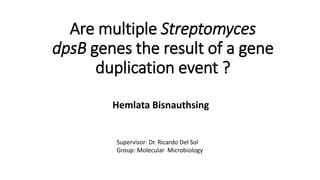presention oral dps project 1 RDSA
•Als PPTX, PDF herunterladen•
0 gefällt mir•93 views
Melden
Teilen
Melden
Teilen

Empfohlen
Empfohlen
Weitere ähnliche Inhalte
Was ist angesagt?
Was ist angesagt? (20)
B.Tech Biotechnology II Elements of Biotechnology Unit 4 DNA Fingerprinting

B.Tech Biotechnology II Elements of Biotechnology Unit 4 DNA Fingerprinting
Recombinant DNA Technology, Forensic DNA Analysis and Human Genome Project

Recombinant DNA Technology, Forensic DNA Analysis and Human Genome Project
Ähnlich wie presention oral dps project 1 RDSA
Ähnlich wie presention oral dps project 1 RDSA (18)
bacterialgeneticsystemfinal-151114160717-lva1-app6891.pdf

bacterialgeneticsystemfinal-151114160717-lva1-app6891.pdf
2017 summer high school textbook (molecular biology and neuroscience)

2017 summer high school textbook (molecular biology and neuroscience)
Fernando de la Cruz - Simposio Microbiología: Transmisión

Fernando de la Cruz - Simposio Microbiología: Transmisión
presention oral dps project 1 RDSA
- 1. Are multiple Streptomyces dpsB genes the result of a gene duplication event ? Hemlata Bisnauthsing Supervisor: Dr. Ricardo Del Sol Group: Molecular Microbiology
- 2. Background • Dps (DNA Protection during Starvation) Encoded by Bacteria and Archea Protect DNA from Oxidative stress • Studies in Streptomyces coelicolor described three Dps-like proteins: DpsA, B and C. dpsB seems to be the ancestral gene in Streptomyces dpsA is stress-inducible and controlled by a sigB promoter dpsC is unusual in sequence and probably laterally acquired from an extremophile organism Facey et al., Mol. Microbiol. (2009)
- 3. Multiple dpsB genes is a common trait in Streptomyces genomes dpsB-like Facey et al. PLoS One. 2013;8(4):e60772. doi: 10.1371/journal.pone.0060772.
- 4. Streptomyces DpsB-like sequences distribute into well defined sub-clades (~200 sequences) Neighbour Joining Tree, 500 replicates. MEGA 5
- 5. Strong synteny between dpsB paralog loci provides evidence for an ancestral duplication event COGE: https://genomevolution.org/CoGe/SynMap.pl
- 6. Only sequences in clade 1B possess a sigB-like promoter, while paralogs in clades 1A ,1C and clade 3 do not Representative dpsB-like from clade 1B that possess a putative sigB-like promoter (predicted using Compass)
- 7. Is this how it happened? Streptomyces last common ancestor (1 dpsB-like) Gene duplication event S. avermitilis S. scabies S. griseus sigBp Lateral gene transfer events dpsB dpsB1 dpsB2 dpsB dpsX dpsC dpsB dpsA S. coelicolor S. albus S. iranensis Gene loss S. venezuelaedpsC Hypothetical Clade 3 organisms?
- 8. Summary • The last common ancestor to Streptomyces underwent a gene duplication event that led to multiple dpsB loci. • One dpsB paralog always possess a sigB promoter, suggesting a role in stress response. • A small number of dpsB orthologs (clade 3) have been laterally acquired from Mycobacteria.